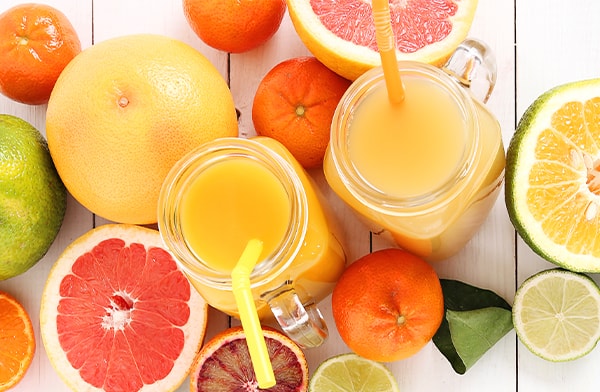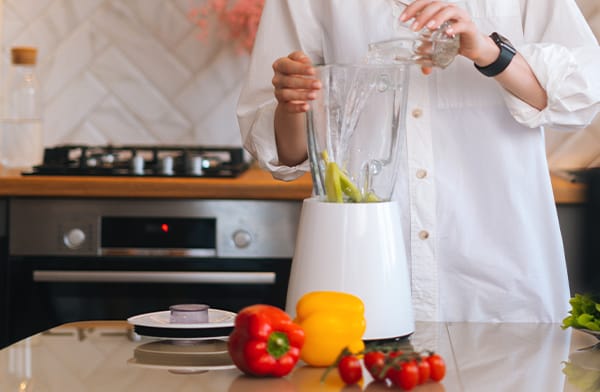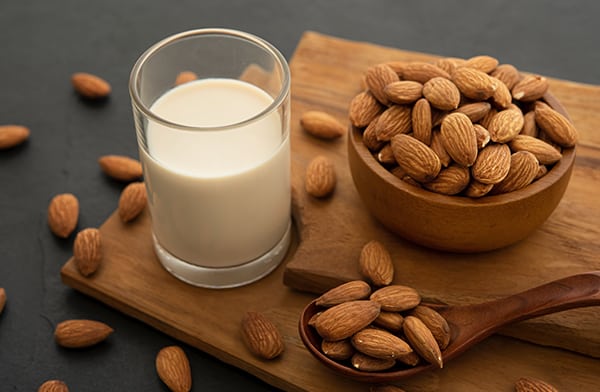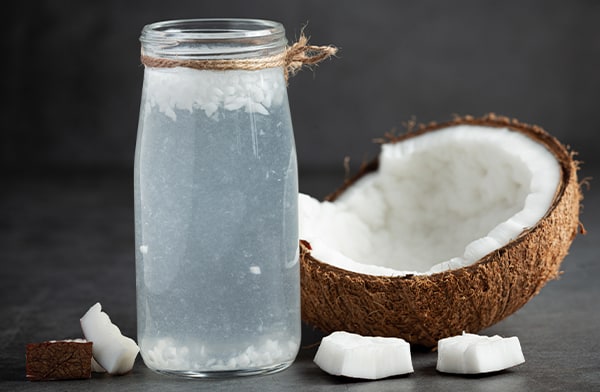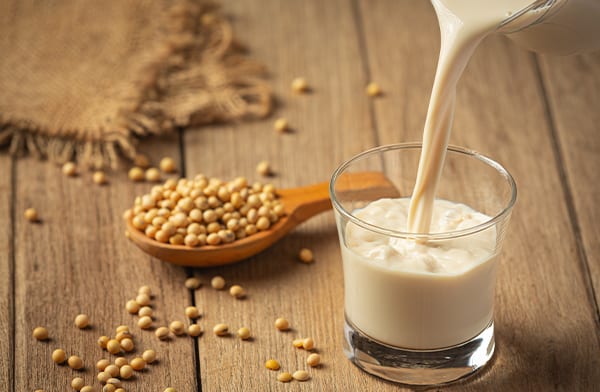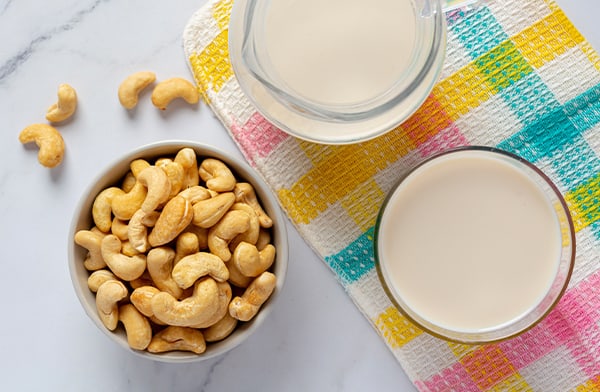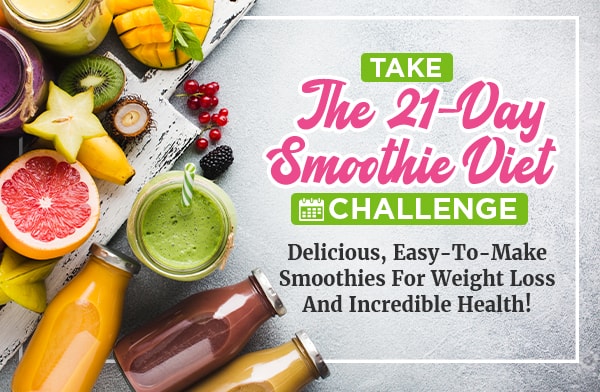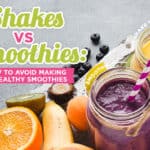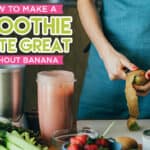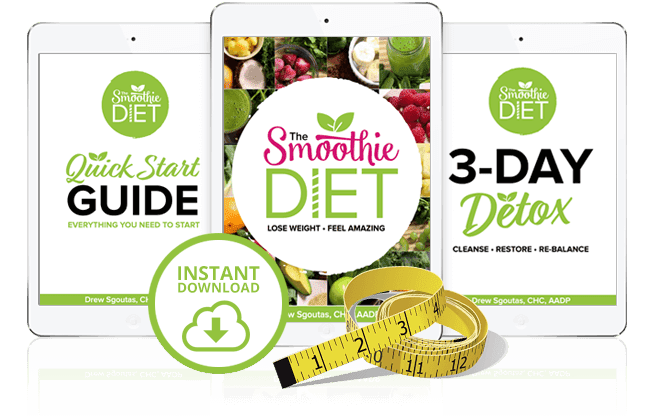5 Non-Dairy Substitutes for Milk in Your Smoothies
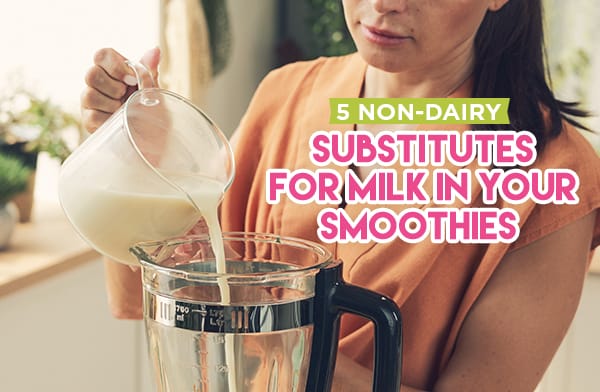
Milk is one of the most common base liquids for smoothies, after water. It adds a wholeness, a richness, to your smoothies. That flavor and texture can be difficult to get in other ways.
There’s just one problem: many people can’t, or don’t want to, drink milk.
- People with lactose intolerance don’t enjoy milk, as it wreaks havoc on their digestive systems.
- People following a strict vegan diet typically skip out on dairy products.
- People dieting or diabetic might not want to drink milk, which is high in lactose, a sugar.
If you’re one of those many people who don’t want to drink milk, you’re not alone. You might feel like smoothies are inaccessible to you, given how frequently they contain dairy products. Luckily, great minds have been working on this problem and have come up with many different alternatives to milk that can make your smoothies rich and whole.
I’ve picked my five favorite non-dairy substitutes for milk to use in smoothies. I’ll tell you all about them, so just keep reading to see the options available to you. Or, if you want to skip ahead to the Smoothie Diet directly, go right ahead! I give you plenty of recipes for smoothies in the program, and they all use non-dairy milk substitutes.
Option -1: Fruit Juice
“Option -1? What?” That’s right; I’m starting with a negative. This “option” is technically something you can use as a liquid for your smoothies, but I will never recommend it.
“But fruit juice is fruit. It’s healthy, right?” Well, no. Fruit juice, when freshly squeezed from a fruit, is mostly healthy. The fruit juices you buy from the store? Not at all. Commercial fruit juices have a lot of problems.
- They remove everything good about a fruit. Part of the reason to eat fruits is because of all of the vitamins, fiber, and other nutrients. All of those nutrients are stored in the pulp and flesh of the fruit, not the juice. The juice alone is mostly sugar, with a few vitamins and minerals. It’s not all that healthy compared to whole fruit.
- They tend to have added sugars and flavors. Most of the fruit juices you find on the market have added ingredients to them. How do you think they make every single bottle taste the same? Fruits taste different from day to day when you pick them; there’s no way they’d be able to keep a juice that consistent without artificial additions or some weird distillation process.
- They’re often laced with preservatives and other nonsense. Fruit juices need to be long-lived, free from pathogens and contaminants, and consistent in color and texture. Usually, to achieve this, juice makers will add preservatives and other chemicals you probably don’t want to drink.
Fruits are good. Fruit juices are mostly just candy water. Keep in mind, too, that a glass of fruit juice won’t keep you satisfied or sate your appetite, but it’s packed with calories. That’s basically the exact opposite of what we want out of a good smoothie.
Option 0: Water
Option zero here is neutral rather than negative. Why is that? Well, water is fine. It’s fine! It works as a basis for a smoothie. But that’s about all I can say about it.
Your body needs water, of course. You should be drinking plenty of water every day to make sure you’re hydrated, and your body has the h2o you need to survive.
Water is also, unfortunately, boring. It doesn’t usually have much flavor, or if it does, the flavor may be unpleasant. It has no additional nutrients, vitamins, or minerals. It provides a liquid for your smoothies and can thin them out, but that’s it. You can use water to adjust the consistency of your smoothies, but I don’t usually recommend using it as a base.
One of the biggest problems with water is that it leaves your smoothies tasting “thin” in a way that goes beyond the consistency of the smoothie. It’s liquid, but it doesn’t add any richness, creaminess, or flavor to your smoothies. All of my recommended milk alternatives make your smoothies taste richer, which helps sate your appetite and makes your smoothie that much more enjoyable.
There’s also the contamination problem. Millions, if not billions of people around the world, have issues with clean water. Water can have all kinds of additives, from fluoride to chemicals meant to protect the pipes (of your house, not your body). There are also all the issues with municipal water supplies being contaminated with lead or some nasty microbe. Well water needs to be treated, too. If you’ve ever had water with sulfur in it, you know you barely want to have it in your house, let alone in something you drink.
To avoid all of that, you’d need to buy bottled water, and that’s expensive and wasteful. Generally, water just isn’t a good option for smoothies all around. It’s a good fallback if you can’t use anything else, but that’s about it.
Option 1: Almond Milk
Now we’re talking. Good old almond milk is one of the oldest staples for non-dairy milk on the market. It’s rich, it’s creamy, it has a nutty taste that can blend excellently with other smoothie ingredients; what’s not to love?
A full cup of almond milk has about 30-35 calories. It’s relatively high in fat (which isn’t bad! Many fats are good for you, including the fats in almonds), and it has both carbs and proteins as well. Compared to cow’s milk, it has half the fat, lower protein, lower carbs, and less than a quarter the calories. It’s also high in Vitamin E, an important antioxidant your body needs.
There are two downsides to almond milk.
The first is that it’s not very concentrated. Almond milk usually contains less than 2% almonds, so while it has nutrition in it, it’s nowhere near as good as just eating some almonds or adding some almond butter to your smoothie mixes. However, that makes it excellent as a base for smoothies! It’s good for consistency and adds a certain richness of flavor you don’t get with other dairy alternatives.
The other concern is more environmental and ethical. Almond farming has a lot of potential issues, and a lot of people don’t want to support an industry where major corporations are essentially stealing water to grow almonds where it’s convenient for them, not where it’s environmentally friendly to do so. However, to get around this problem, you can make sure you’re getting your almond milk from an ethical source.
Option 2: Coconut Milk or Water
Coconuts are a popular source of water in cartoons and folklore, and with good reason. The thick, hard outer shells of these drupes contain succulent flesh and a lot of liquid. That liquid has all the flavor of coconut and plenty of nutrients.
I lumped coconut milk and coconut water together in this section, but they’re actually quite different, and I recommend both in various recipes for smoothies in my diet program.
Coconut milk is made out of the flesh of the coconut, as well as water. It’s rich, creamy, and thick, and it’s much more flavorful than coconut water. It has around 45 calories in a cup, as well as four grams of healthy fats but no carbs or protein. It’s great, especially if you’re trying to watch your carbs or protein intake for medical reasons.
Coconut water, meanwhile, is the liquid found inside the coconut. Young green coconuts have much more water than older brown coconuts because that coconut water is what solidifies into the white flesh of the coconut itself. Coconut water is thinner and less creamy than coconut milk and has correspondingly fewer nutrients in it. It’s still flavorful, but not as creamy, so it goes great in some smoothie recipes that coconut milk wouldn’t.
Keeping both of these on hand is a great way to always have options available to you for smoothie bases. I highly recommend it.
Option 3: Soy Milk
Soy milk is by far the most popular milk alternative, and it was one of the first milk alternatives developed. Soy milk, or a variation of it, has been traced back as far as the Eastern Han dynasty of China, which was all the way back in 25 A.D., nearly 2,000 years ago. It’s a very old and venerable beverage!
Soy milk today is actually losing some popularity. Since soy milk on its own is kind of bland and unpalatable, modern soy milk usually includes some additives like thickeners or vegetable oil to give it a richer and creamier taste. That’s fine for consumption but might not be what you want in a smoothie.
Soy milk is also higher in calories than most dairy alternatives. A cup of the stuff has 90 calories, four grams of fat, eight grams of protein, and four grams of carbs. That’s a lot, especially compared to something like almond or coconut milk. It’s “better” than cow’s milk in that it has half the calories, but otherwise, it’s pretty comparable.
Soy is excellent for one reason, however; it’s one of the few plant-based sources of “complete” proteins, which your body needs. If you’re vegan, you probably know how hard it can be to get all of the appropriate amino acids; soy is one of the few ways you can do that, and soy milk is an easy way to do it.
Option 4: Maple Water
Maple syrup you’ve heard of, sure. I use it as a sweetener sometimes, and it goes great on those decadent breakfasts. What the heck is maple water, though?
Maple water is very quickly becoming a new popular drink. To know what it is, though, you need to know about maple syrup.
Maple syrup is made out of the sap of the sugar maple, which is thin and liquid. That sap is full of nutrients but very thin on flavor; in fact, if you were to drink it straight from the tree, it would taste like slightly woody, slightly sweet water. That’s because, well, it pretty much is. The sugar maple uses that sap to carry its plant nutrients throughout its trunk. We humans tap the tree to drain some of the sap and use it to make syrup. It takes 40-60 gallons of sap to make one gallon of syrup.
Making syrup is easy. All you do is take gallons upon gallons of maple sap and boil it. Boiling it removes the water and concentrates the sugar and nutrients that gives it the characteristic taste.
So, where does maple water come in? Well, it already has. That sap, straight from the tree? That’s maple water. It’s sweet, it’s full of nutrients and electrolytes, and it’s still mostly water. That makes it great for using as a base for a smoothie to add some sweetness without too much effect on the flavor.
The only downside with maple water is that it’s a relatively new product, so it can be hard to find, and there aren’t many people selling it. If you can get some, though, it’s a great option to try.
Option 5: Cashew Milk
Cashews are one of the richest and most flavorful nuts; and also one of the most expensive. Cashew milk is made the same way something like almond milk is, soaking the nuts in water and using that water as a milk alternative. It’s very rich and creamy, so it works well in places dairy milk is usually called for.
Cashew milk is great for another reason, too; you can make it at home. All you need to do is soak raw cashews in water (raw! Don’t get roasted and salted cashews for this.), then rinse, drain, and blend the nuts with more water and some flavorings of your choice.
Regardless of which milk alternative you use, it all comes down to personal taste and flavor profiles. Coconut, almond, cashew; all have their own distinct flavors. If you like them, great! Add them to your smoothies. If not, well, there are plenty of options to try out.
If you have any questions about non-dairy substitutes for your smoothies, or anything else smoothie-related, feel free to ask away in the comments! I’d be more than happy to help however I can.

